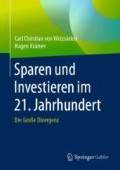Zusammenfassung
Im Wirtschaftsraum der OECD-Länder plus China besteht knapp die Hälfte des privaten Vermögens aus Netto-Staatsschulden. Das private Vermögen ist nahezu doppelt so groß wie das private Realvermögen. Aufgrund der weiter steigenden Lebenserwartung wächst der Anteil der Staatsschulden am privaten Vermögen.
Wenn die Staatsschulden nicht zu hoch werden, können im 21. Jahrhundert die Realzinsen niedrig aber positiv sein. Hauptgrund dafür ist die private Zukunftsvorsorge angesichts hoher Lebenserwartung. Die Investitionen können mit der steigenden privaten Spartätigkeit nicht Schritt halten.
Im 21. Jahrhundert sind die Staatsschulden eine Steuerungsgröße. Mit ihr sorgt die Finanzpolitik dafür, dass auch weiterhin ein positives, aber niedriges Realzinsniveau vorherrscht.
Access this chapter
Tax calculation will be finalised at checkout
Purchases are for personal use only
Preview
Unable to display preview. Download preview PDF.
Literatur
Blanchard, Olivier. 2019. Public Debt and Low Interest Rates, AEA Presidential Lecture 2019. American Economic Review 109 (4): 1197-1229.
Böhm-Bawerk, Eugen Ritter von. 1889. Kapital und Kapitalzins, Zweite Abteilung: Positive Theorie des Kapitales. Jena: G. Fischer.
Bundesverfassungsgericht, BVerfGE 53, 257.
Coase, Ronald H. 1937. The Nature of the Firm. Economica 4 (16): 386-405.
Coase, Ronald H. 1960. The Problem of Social Cost. Journal of Law and Economics 3: 1-44.
Hansen, Alvin H. 1939. Economic Progress and Declining Population Growth. American Economic Review 29 (1): 1-15.
Harberger, Arnold C. 1998. A Vision of the Growth Process. American Economic Review 88 (1): 1-32.
Jastrow, Joseph. 1899. The Mind‘s Eye. Popular Science Monthly 54: 299-312.
Marx, Karl und Friedrich Engels. 1846. Die deutsche Ideologie. In Karl Marx, Die Frühschriften, hrsg. Siegfried Landshut, 339-485. Stuttgart: Kröner 1955.
Meadows, Dennis L., Donella H. Meadows, Jørgen Randers, William W. Behrens III. 1972.
The Limits to Growth. A Report for the Club of Rome‘s Project on the Predicament of Mankind. New York (NY): Universe Books.
Rachel, Lukasz und Lawrence H. Summers. 2019. On Falling Neutral Real Rates, Fiscal Policy, and the Risk of Secular Stagnation. Brookings Papers on Economic Activity March 4: 1-66.
Smith, Adam. 1776. An Inquiry into the Nature and Causes of the Wealth of Nations. London: W. Strahan and T. Cadell.
Summers, Lawrence H. 2013. Speech at IMF Fourteenth Annual Research Conference in Honor of Stanley Fischer. 8 November 2013. Washington (D.C.): International Monetary Fund.
Weizsäcker, Carl Christian von. 2010. Das Janusgesicht der Staatsschulden. Frankfurter Allgemeine Zeitung . 4. Juni 2010: 12 (abgedruckt als Anhang in diesem Buch).
Weizsäcker, Carl Christian von. 2014. Public Debt and Price Stability. German Economic Review 15 (1): 42-61.
Weizsäcker, Carl Christian von. 2019. Capital Theory of the Steady State – Or: T = Z – D. https://www.coll.mpg.de/Weizsaecker/CapitalTheory2019 und https://www.springer.com/9783658273620.Blanchard, Olivier. 2019. Public Debt and Low Interest Rates, AEA Presidential Lecture 2019. American Economic Review 109 (4): 1197-1229.
Böhm-Bawerk, Eugen Ritter von. 1889. Kapital und Kapitalzins, Zweite Abteilung: Positive Theorie des Kapitales. Jena: G. Fischer. Bundesverfassungsgericht, BVerfGE 53, 257.
Coase, Ronald H. 1937. The Nature of the Firm. Economica 4 (16): 386-405.
Coase, Ronald H. 1960. The Problem of Social Cost. Journal of Law and Economics 3: 1-44.
Hansen, Alvin H. 1939. Economic Progress and Declining Population Growth. American Economic Review 29 (1): 1-15.
Harberger, Arnold C. 1998. A Vision of the Growth Process. American Economic Review 88 (1): 1-32.
Jastrow, Joseph. 1899. The Mind‘s Eye. Popular Science Monthly 54: 299-312.
Marx, Karl und Friedrich Engels. 1846. Die deutsche Ideologie. In Karl Marx, Die Fruhschriften, hrsg. Siegfried Landshut, 339-485. Stuttgart: Kröner 1955.
Meadows, Dennis L., Donella H. Meadows, Jørgen Randers, William W. Behrens III. 1972. The Limits to Growth. A Report for the Club of Rome‘s Project on the Predicament of Mankind. New York (NY): Universe Books.
Rachel, Lukasz und Lawrence H. Summers. 2019. On Falling Neutral Real Rates, Fiscal Policy, and the Risk of Secular Stagnation. Brookings Papers on Economic Activity March 4: 1-66.
Smith, Adam. 1776. An Inquiry into the Nature and Causes of the Wealth of Nations. London: W. Strahan and T. Cadell.
Summers, Lawrence H. 2013. Speech at IMF Fourteenth Annual Research Conference in Honor of Stanley Fischer. 8 November 2013. Washington (D.C.): International Monetary Fund.
Weizsäcker, Carl Christian von. 2010. Das Janusgesicht der Staatsschulden. Frankfurter Allgemeine Zeitung . 4. Juni 2010: 12 (abgedruckt als Anhang in diesem Buch).
Weizsäcker, Carl Christian von. 2014. Public Debt and Price Stability. German Economic Review 15 (1): 42-61.
Weizsäcker, Carl Christian von. 2019. Capital Theory of the Steady State – Or: T = Z – D. https://www.coll.mpg.de/Weizsaecker/CapitalTheory2019 und https://www.springer.com/9783658273620.
Author information
Authors and Affiliations
Corresponding author
Rights and permissions
Copyright information
© 2019 Springer Fachmedien Wiesbaden GmbH, ein Teil von Springer Nature
About this chapter
Cite this chapter
von Weizsäcker, C., Krämer, H. (2019). Einleitung: Privates Vermögen und Schulden des Staates. In: Sparen und Investieren im 21. Jahrhundert. Springer Gabler, Wiesbaden. https://doi.org/10.1007/978-3-658-27363-7_1
Download citation
DOI: https://doi.org/10.1007/978-3-658-27363-7_1
Published:
Publisher Name: Springer Gabler, Wiesbaden
Print ISBN: 978-3-658-27362-0
Online ISBN: 978-3-658-27363-7
eBook Packages: Business and Economics (German Language)

